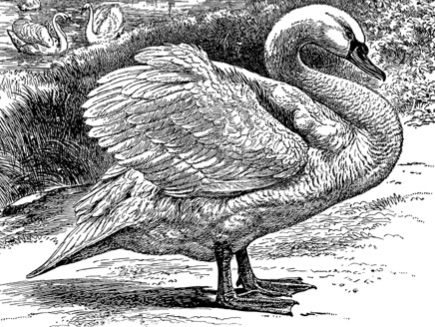The problem of poetry and verse
How should poetry be handled? Is it possible to conserve the form of the original?
Much French poetry is written in alexandrines, in which each line consists of twelve syllables, with a caesura halfway. Such a form of organization makes no sense in English poetry, where metre depends on the number of stresses, irrespective of the number of syllables.
For this reason, I tend to translate French verse of classical form into English blank verse.
Here are two examples.

Writing in 1586, Ronsard urges detachment from material possessions
Il faut laisser maisons et vergers et jardins,
Vaisselles et vaisseaux que l’artisan burine
Et chanter son obsèque en la façon du cygne
Qui chante son trépas sur les bords méandrins
Laissant pourrir çà-bas sa dépouille de boue,
Dont le sort, la fortune et le destin se jouent,
Franc des liens du corps pour n’être qu’un esprit. |
Then leave your houses, orchards, gardens, all
Vases and bowls that artisans engraved
And sing your funeral dirge as does the swan
Which sings her death upon meandering banks
Leaving on earth her rotting corpse of clay,
Plaything of fate, fortune and destiny,
Freed from the body’s bonds as spirit pure. |
Quoted in Rémilleux, A Palace in Sicily (Albin Michel, 2020)

In a futuristic science fiction novel. The poet is in the company of a wonderfully beautiful young woman who owns an individual air transport vehicle, a luxury generally accessible only to the super-rich élite (this one is made in the form of a dragon).

Pauline Pucciano, Titania 2.0, Editions du Net, 2016

But what about rhyming verse?

Here is an amusing anecdote taken from a German company newsletter. It dates from the period when a computer’s monitor screen was often referred to as a Visual Display Unit, or VDU. With a little ingenuity (and a lot of time!) and by taking considerable liberties with the text, it has been possible to preserve the story and also the rhyme scheme, which makes an important contribution to the humorous effect.
|
Eine Panne
Die Lilli kommt am frühen Morgen,
und macht sich um den Bildschirm Sorgen
Knopf ein, Knopf aus, was für ein Graus,
denn leider bleibt der Bildschirm aus.
Ein Mann muss her, der was versteht,
sonst sieht man nicht was draußen geht.
Der Viktor scheint der rechte Mann,
der kriegt das ganz bestimmt in Gang.
Doch der Versuch ist fehlgeschlagen,
er muss es dem Direktor sagen.
Auch dieser kriegt es nicht heraus,
der Auftrag muß nun außer Haus.
Elektro Lehmann tritt zur Stelle,
und rückt dem Ganzen auf die Pelle.
Und siehe da, nach kurzer Zeit,
da weiß der Lehmann schon Bescheid.
Die Rechnung kommt auch ganz schön teuer,
der Fehler ist ja ungeheuer.
Mit einem Schmunzeln auf dem Mund,
gibt er nun sein Ergebnis kund.
Es kann nicht gehen meint er bloß,
denn der Stecker hängt so lose,
er sollte einfach in die Dose. |
The Wire
Lilli starts the day anew:
but what’s wrong with her VDU?
Ten times she switches on the screen,
but not a flicker can be seen.
A man, who knows what he’s about,
will have to come and sort it out.
Now Viktor – he’s the very man!
He’ll get it fixed, or no one can.
But no, he can’t! He’s at a loss.
It’s time to go and tell the boss,
but even he can’t get it clear.
They need an IT engineer!
Lehmann Electric comes along.
He’ll put it right, whatever’s wrong!
He has the answer right away,
but there’s a heavy bill to pay.
What a clanger! Dear, oh dear!
“You’ve got a loose wire dangling here.
A VDU can’t be expected
to work when it’s been disconnected.
You see,” says Lehmann, with a grin,
“to make it work: just plug it in!” |
Note how the comma inserted in line 5 expresses the sexist bias implicit in the German word order!



![]()

